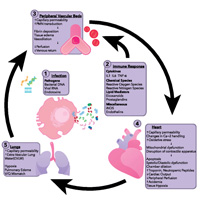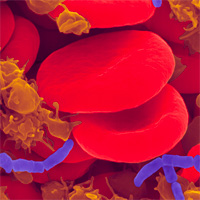Tag: sepsis

Obesity Improves Short-term Survival in Sepsis
In a large cohort study of 55,038 adults hospitalized with sepsis, short-term mortality (death or hospice) was lower in overweight and obese patients compared with those with normal body mass indices (both unadjusted and... read more

Long-term survival in patients with septic acute kidney injury is strongly influenced by renal recovery
In patients with sepsis, recovery by hospital discharge is associated with long-term survival similar to patients without AKI. Of the 1742 patients who survived to hospital discharge, stage 2–3 AKI occurred in 262 (15%),... read more

The Evolution of Lung Protective Ventilation in ARDS
Dr. Jesus Villar is Group Chief of the Center for Biomedical Research in Respiratory Diseases in Madrid and Senior Scientist of the Research Unit at the Hospital Universitario Dr. Negrin in Las Palmas, Spain. He is the Coordinator... read more

Loss of Sphingosine 1-Phosphate in Septic Shock is Predominantly Caused by Decreased Levels of HDL
Sphingosine 1-phosphate (S1P) is a signaling lipid essential in regulating processes involved in sepsis pathophysiology, including endothelial permeability and vascular tone. Serum S1P is progressively reduced in sepsis patients... read more

CRRT for Sepsis-induced Acute Kidney Injury
Sepsis-induced acute kidney injury (SI-AKI) represents the first cause of AKI in ICUs, and renal replacement therapy (RRT) is frequently applied in advanced AKI stages. The debate between 'rescue' indications for RRT start... read more

Antibiotics for Sepsis – Finding the Equilibrium
Sepsis is medicine’s last remaining preserve for unrestrained antibiotic prescribing. The Surviving Sepsis Campaign guidelines recommend empirical broad-spectrum therapy within one hour of triage for both sepsis and septic... read more

Ascorbic Acid, Corticosteroids, and Thiamine in Sepsis
The combination of thiamine, ascorbic acid, and corticosteroids is a promising new therapy for sepsis resuscitation but currently lacks robust evidence to support its widespread use. The potential effectiveness of this medication... read more

Neutrophil Extracellular Traps (NETs) Exacerbate Severity of Infant Sepsis
Neutrophil extracellular traps (NETs) are innate defense mechanisms that are also implicated in the pathogenesis of organ dysfunction. However, the role of NETs in pediatric sepsis is unknown. This study reveals a hitherto... read more

Pathophysiology, echocardiographic evaluation, biomarker findings, and prognostic implications of septic cardiomyopathy
As a result of conflicting data, echocardiographic measures of left ventricular (systolic or diastolic) or right ventricular function cannot currently provide reliable prognostic information in patients with sepsis. Natriuretic... read more

Updates and Controversies in the Early Management of Sepsis and Septic Shock
For patients in the ED who are suspected of having sepsis, swift, effective management is vital to improving outcomes. This issue reviews the latest evidence on the diagnosis and treatment of sepsis and septic shock: ... read more

Vasopressors in Sepsis in 2050
Vasopressors are used in sepsis when hypotension is assumed to be mainly due to a decreased arterial tone. However, the appropriate time to initiate vasopressors is not clearly defined, and fluid administration is most... read more

Unsupervised Analysis of Transcriptomics in Bacterial Sepsis Across Multiple Datasets Reveals Three Robust Clusters
The three sepsis subtypes may represent a unifying framework for understanding the molecular heterogeneity of the sepsis syndrome. Further study could potentially enable a precision medicine approach of matching novel immunomodulatory... read more

Sepsis and Septic Shock – What Matters from EM Cases Course
In this podcast Dr. Sara Gray, intensivist and emergency physician, co-author of The CAEP Sepsis Guidelines, answers questions such as: How does one best recognize occult septic shock? How does SIRS, qSOFA and NEWS compare... read more

Left ventricular systolic function evaluated by strain echocardiography and relationship with mortality in patients with severe sepsis or septic shock
Worse global longitudinal strain (GLS) (less negative) values are associated with higher mortality in patients with severe sepsis or septic shock, while such association is not valid for left ventricular ejection fraction... read more








